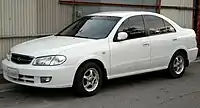Nissan Sylphy
The Nissan Sylphy (Japanese: 日産・シルフィ, Nissan Shirufi) (previously until 2012 known as Nissan Bluebird Sylphy) is a compact car, produced by the Japanese car maker Nissan, as the successor to the Nissan Pulsar. Built since 2000 and currently in its third generation, the second generation is still manufactured for certain markets. Sylphy has also been marketed in export markets under several other model names, including Pulsar and Sentra.
| Nissan Sylphy | |
|---|---|
 Nissan Bluebird Sylphy (G11) | |
| Overview | |
| Manufacturer | Nissan |
| Production | 2000–present |
| Body and chassis | |
| Class | Compact car (C) |
| Chronology | |
| Predecessor | Nissan Sunny Nissan Pulsar Nissan Presea |
The initial Bluebird Sylphy nameplate was a continuation for the larger Nissan Bluebird which was phased out in 2001. It was renamed the Nissan Sylphy in 2012.
First generation (G10/N16; 2000)
| First generation (G10/N16) | |
|---|---|
 2000–2003 Nissan Bluebird Sylphy sedan (Japan) | |
| Overview | |
| Also called | Nissan Bluebird Sylphy Nissan Almera Nissan Pulsar Nissan Sentra (Indonesia/Taiwan/Philippines) Nissan Sunny (Southeast Asia) Renault Samsung SM3 Renault Scala |
| Production | 2000–2005 (G10) 2005–2012 (N16) (Malaysia) |
| Assembly | Japan: Oppama Plant, Yokosuka, Kanagawa China: Guangzhou (DMCL) Malaysia: Kuala Lumpur Philippines: Santa Rosa City Taiwan: Miaoli Thailand: Samut Prakan United Kingdom: Washington, Tyne and Wear (Almera/Pulsar) |
| Body and chassis | |
| Body style | 4-door sedan 5-door hatchback (Pulsar) |
| Layout | Transverse front-engine, front-wheel-drive Transverse front-engine, four-wheel-drive |
| Platform | Nissan MS platform |
| Related | Nissan Sentra (B15) (North America) Nissan Sunny (B15) (Japan) |
| Powertrain | |
| Engine | |
| Transmission | 5-speed manual 4-speed automatic |
| Dimensions | |
| Wheelbase | 2,550 mm (100.4 in) |
| Length | 4,495 mm (177.0 in) |
| Width | 1,695 mm (66.7 in) |
| Height | 1,445 mm (56.9 in) |
| Curb weight | 1,130–1,220 kg (2,490–2,690 lb) |


Nissan launched the G10 or N16 series Bluebird Sylphy in August 2000 as replacement in the Japanese market for the Nissan Pulsar (N15), and it was exclusive to Japanese dealerships called Nissan Blue Stage. The model code of "G10" used in Japan differed from most other markets which retained the legacy N-series (N16) naming scheme inherited from the Pulsar. The change in name from Pulsar to Bluebird Sylphy in Japan came about as Nissan was about to phase out the long-running Bluebird, and this kept the old name alive. Export markets received this same vehicle under a myriad of alternative names: Almera in Europe and Brunei; Pulsar in Australasia; Sentra in Indonesia, Malaysia, the Philippines and Taiwan; plus Sunny in Hong Kong, Singapore, Thailand, Sri Lanka and the Middle East. It was not available in North America; instead, there was the Sunny-based Nissan Sentra (B15).
The Bluebird Sylphy was made available in a single body style, a well equipped small four-door sedan. The factory in the UK, where the N16 was manufactured as the Almera, continued to produce three- and five-door hatchback versions. These European models featured slightly different frontal styling—a unique grille, bonnet and bumper accommodated the headlamp design shared with Japanese models. Some European markets also received an Almera sedan model, which featured the same frontal styling as the hatchbacks. British-made Almeras also saw some exports outside of Europe, mainly to Australia and with Pulsar badging.
The new platform spawned a compact MPV version (the Nissan Almera Tino or Nissan Tino) for the first time. The Nissan Wingroad continued to be sold as the Pulsar wagon or Almera Traveller in many countries.
The original release Bluebird Sylphy had a vertical chrome grille with Nissan emblem on the bonnet. In February 2003, the Bluebird Sylphy received minor changes with a revised grille (with the Nissan emblem moved onto the grille) and an all-new rear end with Teana (J31)-inspired tail lights. This update also applied to the Sunny and Sentra models in Southeast Asia. Australian Pulsar sedans received the same update, although a horizontally-stated grille featured instead.
In October 2005, the second generation Nissan Bluebird Sylphy (G11 series) was previewed at the Tokyo Motor Show. In Japan, the Nissan Tiida hatchback and Tiida Latio sedan replaced also replaced the G10/N16 range, particularly in export markets where the G11 was not offered.
Although the release of the G11 series Sylphy and Tiida signified the withdrawal of the G10/N16 from many markets, it was facelifted for an October 2005 release as a budget model to sit beneath the G11 Sylphy and Tiida in Southeast Asian markets such as Malaysia, Singapore and Thailand. This more substantial front-end facelift allowed for the fitment of reshaped headlamps, a revised front bumper and fenders, and a new grille and bonnet.[1]
Asia
_(first_generation%252C_second_facelift)_(front)%252C_Serdang.jpg.webp)
_(first_generation%252C_second_facelift)_(rear)%252C_Serdang.jpg.webp)
.jpg.webp)
In Japan, the Nissan Revival Plan was implemented, and saw the reorganization of Nissan's Japanese dealership network, introducing Nissan Red Stage as the sole provider of all Sunny/Pulsar vehicle platforms formerly available at Nissan Satio/Nissan Cherry/Nissan Prince locations. Engine choices consisted of the 1.5- QG15DE, 1.6- QG16DE, 1.8- QG18DE, and the 2.0-litre QR20DD. A five-speed manual transmission is only available for the 1.5-litre, the other models featuring a four-speed automatic transmission with the 2.0l motor mated to a CVT. The four-wheel drive version was only offered with the 1.8-litre model.
In Thailand, where the Sunny name was used, alongside the sedan, the five-door was also sold (imported from the UK). Consequently, each body style has a different front end. China, Singapore and Sri Lanka also received the sedan model only under the Sunny name. In China, it was produced by the Dongfeng Motor Company, a joint venture with Nissan.
In Singapore, the N16 succeeded the B15 model in the year 2000. It was available in two engine variants, both 1.5-litre and 1.6-litre. In 2004, a facelifted model was introduced. The facelifted model was only available with a 1.6-litre engine. It continued to be available for sale, until the year 2011. Both versions came in manual and automatic transmissions. Nissan Sunny was only sold in the sedan variant, imported from Japan.
The N16 generation was introduced in the Philippines[2] (where it is sold as Sentra 200 and replaces Pulsar-based N16 model).[3] Sales ended in the Philippine market in 2014.[4]
In Indonesia, Malaysia, the Philippines and Taiwan, the Bluebird Sylphy is sold as the Nissan Sentra. For Indonesia, Nissan sold the Sentra between 2002 and 2004 in small numbers for private buyers in a single trim level, the 1.8 Super Saloon. It featured standard ABS, dual airbags, leather interior, and CD player with MP3. The facelifted model N16, the Sunny Neo was powered by the 1.6-litre engine was and intended for taxi use only.
After the Japanese production ended in 2005, the N16 maintained in production in Malaysia and the Philippines as the Sentra—albeit, sporting new front-end styling treatment. The models for Malaysia are SG and SG-L, with the choice of Comfort or Luxury Package. The Sunny continued to be offered in Singapore until 2011 in the following trim levels: EX Saloon, Super Saloon, and Luxury Edition. Exclusive for the local market, the Malaysian-built N16 was made available until 2014 as the Sentra Sport 1.6 in Comfort and Luxury trim levels. It is unrelated to the North American Sentra.
Australia
In Australia and New Zealand, Nissan continued to use the Pulsar name for the N16 series. The four-door sedan sourced from Japan and the five-door hatchback from the UK (a rebadged Almera) were offered. Consequently, each body style has a different front end.
Trim levels were LX, ST, Q and Ti. Engine choices consisted of the 1.6- and 1.8-litre petrols. Power output was 88 kW (118 hp) and 94 kW (126 hp). The four-door was available in four trim levels—an LX with the 1.6, the ST and Ti with the 1.8-litre engine as standard, and a Q version with the 1.8-litre and a sportier level of trim, including a rear spoiler and alloy wheels. In the five-door range there was no LX version. Nissan launched the hatchback model with the ST trim level and a sporty Q version. As such, all hatches were 1.8-litre powered. The base-model LX sedan came with a driver's airbag, air-conditioning, remote locking and power mirrors, although no anti-lock brakes (ABS) or power windows were offered. The ST five-door gained an extra front airbag, whereas the four-door model did not have one as standard. In Ti form, the four-door gained both front airbags, ABS, climate control air-conditioning, alloy wheels and power windows. The Q model was similar to the Ti four-door, although there were slight discrepancies between the sedan and hatch, with the latter version having an extra air-bag and 15-inch alloy wheels versus the 14-inch alloys on the sedan.
_ST-L_sedan_(2015-07-24)_01.jpg.webp) 2000–2003 Nissan Pulsar ST-L sedan (Australia)
2000–2003 Nissan Pulsar ST-L sedan (Australia)_ST_sedan_(2016-01-04)_02.jpg.webp) 2000–2003 Nissan Pulsar 1.8 ST sedan (Australia)
2000–2003 Nissan Pulsar 1.8 ST sedan (Australia)_ST_5-door_hatchback_(2015-08-07)_01.jpg.webp) 2001–2002 Nissan Pulsar 1.8 ST 5-door (Australia)
2001–2002 Nissan Pulsar 1.8 ST 5-door (Australia)_ST_5-door_hatchback_(2015-08-07)_02.jpg.webp) 2001–2002 Nissan Pulsar 1.8 ST 5-door (Australia)
2001–2002 Nissan Pulsar 1.8 ST 5-door (Australia)_ST-L_sedan_(2015-07-03)_01.jpg.webp) 2003–2005 Nissan Pulsar 1.8 ST-L sedan (Australia)
2003–2005 Nissan Pulsar 1.8 ST-L sedan (Australia)_ST_sedan_(2015-08-07)_02.jpg.webp) 2003–2005 Nissan Pulsar ST sedan (Australia)
2003–2005 Nissan Pulsar ST sedan (Australia)
Europe
For the European market, Nissan sold the N16 series as the second generation Nissan Almera from 2000. Produced in the United Kingdom, the Almera range comprised three- and five-door hatchbacks and the less common sedan. Compared to other markets, the European-manufactured cars featured unique frontal styling — while the headlamps remained common with Japanese models — a restyled grille, bonnet, and bumper did feature. A facelift was released in 2003, with production continuing until the Almera's demise in 2006.
 2000–2003 Nissan Almera sedan
2000–2003 Nissan Almera sedan 2000–2003 Nissan Almera sedan
2000–2003 Nissan Almera sedan 2000–2003 Nissan Almera 5-door
2000–2003 Nissan Almera 5-door 2003–2006 Nissan Almera 5-door
2003–2006 Nissan Almera 5-door 2003–2006 Nissan Almera 3-door
2003–2006 Nissan Almera 3-door
Renault Samsung SM3
Since 2006, a derivative of the Bluebird Sylphy, the Renault Samsung SM3 was sold in Ukraine and Russia as the Nissan Almera Classic. The same year, the car was launched in Central and South America as Nissan Almera, (except in Chile where it was sold as a Samsung). Also since 2007, the Renault Samsung SM3 is sold as the Nissan Sunny in the Middle East,[5] with a solitary trim that comes with a 1.5-litre engine. The Samsung SM3 is also sold as the Renault Scala in Mexico,[6][7] Egypt[8] and Colombia.[9]
 Renault Samsung SM3
Renault Samsung SM3.jpg.webp) Renault Samsung SM3 (facelift)
Renault Samsung SM3 (facelift) Renault Scala (Mexico)
Renault Scala (Mexico) Nissan Almera Classic (Russia)
Nissan Almera Classic (Russia) Nissan Almera Classic (Russia)
Nissan Almera Classic (Russia) Nissan Almera Classic (Russia)
Nissan Almera Classic (Russia)
Second generation (G11; 2005)
| Second generation (G11) | |
|---|---|
_(front)%252C_Kuala_Lumpur.jpg.webp) | |
| Overview | |
| Also called | Nissan Bluebird Sylphy Nissan Bluebird (Taiwan) Nissan Almera (Russia) |
| Production | 2005–2012 (Japan) 2006–2018 (China) 2008–2014 (Malaysia) 2012–2018 (Russia) |
| Model years | 2006–2019 (China) |
| Assembly | Japan: Oppama Plant, Yokosuka, Kanagawa China: Guangzhou (DMCL) Malaysia: Serendah (TCMA) Russia: Tolyatti Taiwan: Miaoli |
| Body and chassis | |
| Layout | Front-engine, front-wheel-drive |
| Platform | Nissan B platform |
| Related | Nissan Sentra B16 Dongfeng Fengshen A60 |
| Powertrain | |
| Engine | |
| Transmission | 5-speed manual 4-speed automatic CVT automatic |
| Dimensions | |
| Wheelbase | 2,700 mm (106.3 in) |
| Length | 4,610 mm (181.5 in) 4,665 mm (183.7 in) (Nissan Sylphy Classic) |
| Width | 1,695 mm (66.7 in) 1,700 mm (66.9 in) (Nissan Sylphy Classic) |
| Height | 1,510 mm (59.4 in) 1,505 mm (59.3 in) (Nissan Sylphy Classic) |
| Curb weight | 1,160–1,250 kg (2,560–2,760 lb) |

The G11 series Bluebird Sylphy uses Nissan's B platform,[10] and the model code is G11. This car was launched at the 2005 Tokyo Motor Show.
In Japan, it replaced the Nissan Sunny (B15) and the previous Bluebird Sylphy as Nissan's compact sedan. The Nissan Bluebird Sylphy uses the same engine as the Nissan Tiida/Versa/Latio, which is the 1.5-litre HR15DE engine and the all-new 2.0-litre MR20DE engine. The 2.0-litre version uses Nissan's Xtronic Continuously Variable Transmission (Xtronic-CVT).
The Sylphy has the most spacious interior space due to its enlarged wheelbase (2,700 mm) and the biggest boot (504 L) in its class. The rear legroom almost matches that of the Nissan Teana and Toyota Camry.
Starting from 2008, the Bluebird Sylphy is also available for the export market, as the Nissan Sylphy. The Sylphy has been sold in China since 2006 under the Sylphy Classic name or 日产轩逸经典 in Chinese. In terms of styling, the Chinese variant has amber turn signals on the front compared to clear ones sold in international markets. The rear was the same style as international variants until 2008 where it was given a facelift for 2009. The rear was given new taillights as well as an extra foglamp on the bottom of the rear bumper. Trim levels consisted of the 1.6XE, 2.0XE, 2.0XL, 2.0XV and 2.0XV Navi. Engine and gearbox options consisted of the 1.6 litre HR16DE and the 2.0 litre MR20DE paired to a 5-speed manual, 4-speed automatic, or a CVT gearbox.[11] Production for the Classic Sylphy ended in 2018 for the 2019 model year.
The Sylphy was also sold in some Southeast Asian countries such as Malaysia and Taiwan. The Yulon Motor Company of Taiwan manufactured the Bluebird Sylphy and sold it as the Nissan Bluebird.[12]
In Malaysia, the G11 Sylphy was launched in June 2008. Two variants were offered: Comfort and Luxury. Both variants were powered by Nissan's MR20DE engine paired to a CVT.[13] In June 2009, 'Tuned by Impul' accessories were made available and consisted of a front grille, front and rear lips, side skirts, a rear wing spoiler, suspension and alloy wheels.[14] In January 2010, a new variant dubbed 'Luxury Navi Package' offered navigation and a reverse camera.[15] In March 2012, the facelift G11 Sylphy was launched in Malaysia and was available with three variants: 2.0 XL Comfort and 2.0 XL Luxury and 2.0 XV Premium.[16] In June 2012, revised 'Tuned by Impul' accessories were launched.[17]
In Russia, the Bluebird Sylphy was available between 2012 and 2018 as the Nissan Almera. The production started in fall of 2012 in the AvtoVAZ plant in Tolyatti. The car is available with the 1.6-liter 76 kW (102 hp) engine and five-speed manual or four-speed automatic transmission.
Pre-facelift styling
 Front
Front Rear
Rear
Post-facelift styling
 Front
Front Rear
Rear
Third generation (B17; 2012)
The 2013 Nissan Sylphy was revealed at the 2012 Beijing Auto Show.[18] To reduce development costs, the development of the car is merged with the Nissan Sentra, which meant it is a rebadged seventh generation Sentra with several changes to accommodate the taste of Asian customers.
_1.8_Premium_sedan_(2017-11-28).jpg.webp) Nissan Sylphy B17 (Singapore; pre-facelift)
Nissan Sylphy B17 (Singapore; pre-facelift)_1.8_Premium_sedan_(2017-11-29).jpg.webp) Nissan Sylphy B17 (Singapore; pre-facelift)
Nissan Sylphy B17 (Singapore; pre-facelift) Facelift (China)
Facelift (China) Facelift (China)
Facelift (China)
Fourth generation (B18; 2019)
The fourth generation Sylphy was unveiled on 16 April 2019 at the 18th Shanghai International Automobile Industry Exhibition.[19][20] It was revealed prior to the Sentra which was launched later that year at the 2019 Los Angeles Auto Show.[21]
.jpg.webp) Nissan Sylphy B18 (China)
Nissan Sylphy B18 (China).jpg.webp) Nissan Sylphy B18 (China)
Nissan Sylphy B18 (China)
Sales
| Calendar Year | China[22] | Thailand |
|---|---|---|
| 2006 | 55,999 | |
| 2007 | 61,386 | |
| 2008 | 52,640 | |
| 2009 | 96,174 | |
| 2010 | 142,511 | |
| 2011 | 125,427 | |
| 2012 | 133,823 | |
| 2013 | 259,545 | |
| 2014 | 300,058 | 3,645[23] |
| 2015 | 334,087 | 2,978[24] |
| 2016 | 367,979 | 1,223[25] |
| 2017 | 404,726 | 1,155[26] |
| 2018 | 481,216 | 1,206 |
| 2019 | 470,707 |
References
- Tan, Paul (13 October 2005). "New Nissan Sentra facelift in Malaysia". Paul Tan's Automotive News. Retrieved 11 November 2013.
- "Nissan Motor Philippines launches Sentra 200", TopGear.com.ph, June 20, 2010. Retrieved May 1, 2011.
- Roces, Iñigo. "Not In the Specs", AutoIndustriya.com, June 30, 2010. Retrieved May 1, 2011.
- http://myk384.blogspot.com/2017/02/car-features-same-car-different.html
- "Nissan Sunny Ultimate Car Buyer Guide". drivearabia.com. Retrieved 7 July 2008.
- "Renault Scala". Renault.com.mx. Retrieved 25 July 2010.
- CHACAL (30 May 2010). "Renault Scala llega a Mexico – Mundoautomotor México". Mundoautomotor.com.mx. Archived from the original on 9 May 2012. Retrieved 25 July 2010.
- "Renault Scala on ContactCars.com – Egypt". ContactCars.com. Archived from the original on 19 June 2012. Retrieved 14 November 2010.
- "Sofasa-Renault presentó el sedán Scala en Colombia – Principales noticias de Colombia y el mundo". Eltiempo.Com. Retrieved 25 July 2010.
- "Motor Trader Car News". motortrader.com.my. Archived from the original on 2010-06-03. Retrieved 2009-07-30.
- "2009 Nissan Sylphy Classic specs".
- http://www.nissan.com.tw/car/bluebird/index.asp
- "Nissan Sylphy 2.0 CVTC Launched in Malaysia!". Paul Tan's Automotive News. 2008-06-27. Retrieved 2019-01-22.
- "ETCM's new Nissan Sylphy tuned by Impul". Paul Tan's Automotive News. 2009-06-18. Retrieved 2019-01-22.
- "New Nissan Sylphy Luxury Navi Package trim level adds in-dash GPS navigation system". Paul Tan's Automotive News. 2010-01-14. Retrieved 2019-01-22.
- "Nissan Sylphy updated - two trim levels, plenty of new kit". Paul Tan's Automotive News. 2012-03-09. Retrieved 2019-01-22.
- "Nissan Sylphy and Livina X-Gear Tuned by Impul unveiled at Super GT Round 3 in SIC". Paul Tan's Automotive News. 2012-06-11. Retrieved 2019-01-22.
- "2013 Nissan Sentra Teased, New Sedan Previewed as Sylphy at Beijing Show"., Motor Trend, April 23, 2012. Retrieved April 23, 2012.
- https://www.carscoops.com/2019/04/all-new-nissan-sylphy-launches-in-shanghai-and-previews-new-sentra/
- https://www.autoindustriya.com/auto-industry-news/this-2020-sylphy-shows-us-nissan-wants-to-win.html
- https://www.motor1.com/news/383243/2020-nissan-sentra-debut-details/
- Sales, ModelNissan Car SalesNissan Model (2015-04-22). "Nissan Sylphy China auto sales figures". carsalesbase.com. Retrieved 2020-10-09.
- "Thailand cars sales report 2014". HeadlightMag.com. Thailand. Retrieved 24 Oct 2018.
- "Thailand cars sales report 2015". HeadlightMag.com. Thailand. Retrieved 24 Oct 2018.
- "Thailand cars sales report 2016". HeadlightMag.com. Thailand. Retrieved 24 Oct 2018.
- "Thailand cars sales report 2017". HeadlightMag.com. Thailand. Retrieved 24 Oct 2018.
External links
| Wikimedia Commons has media related to Nissan Sylphy. |